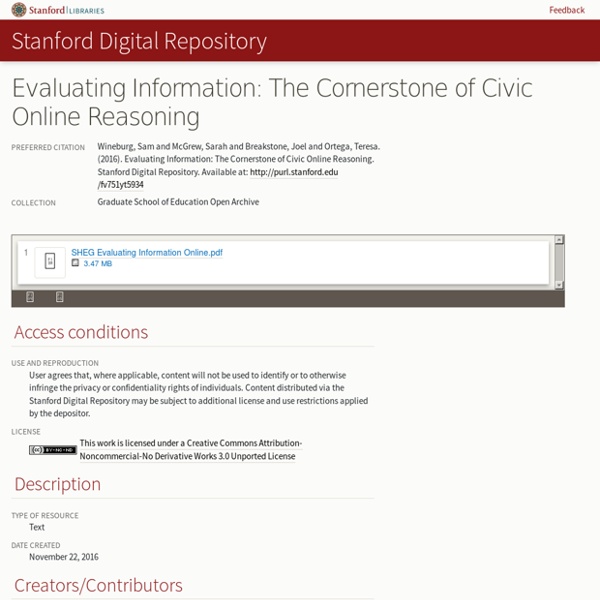



https://purl.stanford.edu/fv751yt5934
Related: COLLECTION: Media Literacy and Fake News • digital literacyBreaking News Consumer's Handbook: Fake News Edition BROOKE GLADSTONE: Drawing a distinction between fake and real news is going to be hard for those Facebook and Google employees tasked with bird dogging offending sites, but it shouldn’t be so hard for you, the consumer. Melissa Zimdars, professor of communication and media at Merrimack College, has made a list of more than a hundred problematic news sites, along with tips for sorting out the truthful from the troublesome. She got into the fake news sorting racket after a hot tip. MELISSA ZIMDARS: Someone alerted me to the fact that when you searched for the popular vote on Google, the first Google news item that came up was a fake news website saying that Hillary Clinton lost the popular vote. Truth, truthiness, triangulation: A news literacy toolkit for a “post-truth” world We were guaranteed a free press, We were not guaranteed a neutral or a true press. We can celebrate the journalistic freedom to publish without interference from the state. We can also celebrate our freedom to share multiple stories through multiple lenses. But it has always been up to the reader or viewer to make the reliability and credibility decisions. It is up to the reader or viewer to negotiate truth. News literacy is complicated.
Introducing This Is Fake, Slate’s tool for stopping fake news on Facebook. One of the more extreme symptoms of media dysfunction in the past several months has been the ascendance of “fake news”—fabricated news stories that purport to be factual. The phenomenon is not altogether novel, but the scale at which it is now being produced and consumed is unprecedented. A BuzzFeed data analysis found that viral stories falsely claiming that the Pope had endorsed Donald Trump, that Hillary Clinton was implicated in the murder of an FBI agent, that Clinton had sold weapons to ISIS, all received more Facebook engagement than the most popular news stories from established outlets such as the New York Times and CNN.
Northstar Digital Literacy This page includes a variety of publicly available learning resources for the Northstar standards. These resources are not created by Northstar, but have been selected by our staff. We also provide comprehensive classroom curricula for each assessment, which have been created by Northstar - these curricula are available only through Northstar testing locations. Learn more about becoming a testing location. Study: Students show ‘troubling’ lack of news literacy skills — News Literacy Project A new report from the Stanford History Education Group has found little change in high school students’ ability to evaluate information online since 2016, when SHEG researchers released the results of a similar study. This skill set — dubbed “civic online reasoning” by Stanford researchers — consists of the ability to recognize advertising, including branded content; to evaluate claims and evidence presented online; and to correctly distinguish between reliable and untrustworthy websites and other sources of information. (The executive summary of the 2016 study summed up “young people’s ability to reason about the information on the Internet” in one word: “bleak” — and the executive summary of the latest report acknowledged that “the results — if they can be summarized in a word — are troubling.”)
Northstar Digital Literacy March 18, 2020 Updated 7/16/20 with information on 1:1 Digital Literacy Skills Volunteer Tutor Plans. Testing locations: as the COVID-19 situation progresses, we are aware that the ways in which testing locations use Northstar may well change. We hope you feel free to be creative and try new ways of helping people master digital literacy skills - which are even more crucial as so much of daily life moves online. Analyzing News Sources - Fake News - Library Home at Notre Dame de Namur University confirmation bias: the tendency to believe information is credible if it conforms to the reader’s/viewer’s existing belief system, or not credible if it does not conform content farm or content mill: a company that employs a staff of freelance writers to create content designed to satisfy search engine retrieval algorithms with the goal of attracting views and advertising revenue echo chamber: a situation in which information, ideas, or beliefs are amplified or reinforced by transmission and repetition inside an “enclosed” system, where different or competing views are censored, disallowed, or otherwise underrepresented fact checking: the act of verifying assertions either prior to publication or after dissemination of the content
Reading Online Home › Professional Development › Strategy Guides Strategy Guide Research suggests that online reading requires a different set of skills and strategies than offline reading. These different skills and strategies are required because online reading is frequently information seeking, guided by the reader (rather than the teacher) and non-linear (readers follow a series of hyperlinks and navigate through multiple windows rather than reading something from beginning to end). The skills required for successful online reading are: the ability to formulate appropriate questions, locate reliable information, and evaluate, synthesize and communicate that information. Additionally, because online reading occurs within rapidly changing technology that may or may not be familiar to teachers, and students are frequently engaged with outside of school, lessons that build on students’ prior knowledge of these technologies can and should be employed.